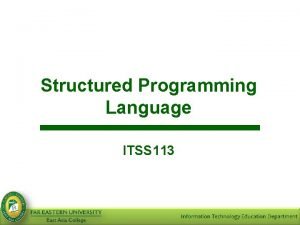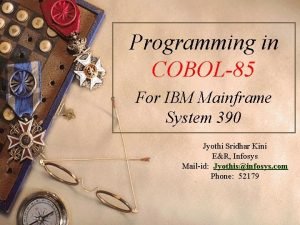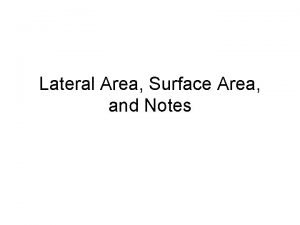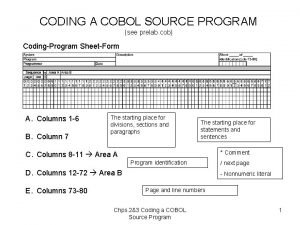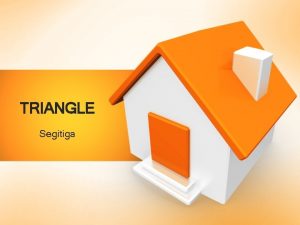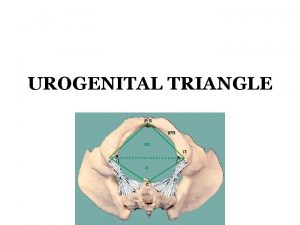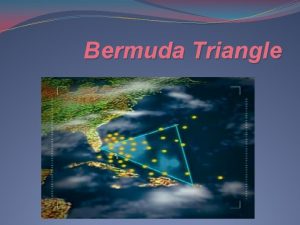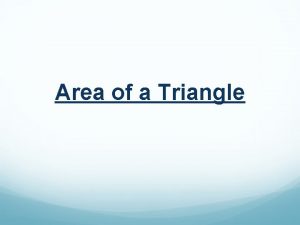Area of a triangle Parts of a triangle






- Slides: 6

Area of a triangle

Parts of a triangle • Base: any side of a triangle can be called the base • Altitude: the perpendicular segment from a vertex to a line on the base • The height of the triangle is determined by the length of the altitude base The contents of this content module were developed by special educator Bethany Smith, Ph. D and validated by content expert Drew Polly, Ph. D at University of North Carolina at Charlotte under a grant from the Department of Education (PR/Award #: H 373 X 100002, Project Officer, Susan. Weigert@Ed. gov). However, the contents do not necessarily represent the policy of the Department of Education and no assumption of endorsement by the Federal government should be made

Area of a triangle: An example A = ½bh height base Step 1: A= ½ (15)(3) 3 Step 2: A= ½ (45) 15 Step 3: A=22. 5 Helpful Hint: Remember to review order of operations. Students must square r before they multiply by π The contents of this content module were developed by special educator Bethany Smith, Ph. D and validated by content expert Drew Polly, Ph. D at University of North Carolina at Charlotte under a grant from the Department of Education (PR/Award #: H 373 X 100002, Project Officer, Susan. Weigert@Ed. gov). However, the contents do not necessarily represent the policy of the Department of Education and no assumption of endorsement by the Federal government should be made

Ideas for application • Use area formula to find the area of a rectangle. Then, divide the rectangle into two triangle and find the area of both triangles. Compare solutions to show that the area of the rectangle and the area of the two triangles are the same. • Provide triangles on graph papers so students can calculate the length of the base and altitude as well as the area of the triangle. • Have students with and without disabilities work together to prove that any side of a triangle can be chosen as the base. The contents of this content module were developed by special educator Bethany Smith, Ph. D and validated by content expert Drew Polly, Ph. D at University of North Carolina at Charlotte under a grant from the Department of Education (PR/Award #: H 373 X 100002, Project Officer, Susan. Weigert@Ed. gov). However, the contents do not necessarily represent the policy of the Department of Education and no assumption of endorsement by the Federal government should be made

Suggestion to increase difficulty • Provide the area and one variable and have the student find the missing attribute – For Example, if 22. 5=1/2(15)h, what is the value of h? • Provide students with less familiar shapes made up of triangles and ask them to find the area by dividing the shape into triangles and adding their volume – For example The contents of this content module were developed by special educator Bethany Smith, Ph. D and validated by content expert Drew Polly, Ph. D at University of North Carolina at Charlotte under a grant from the Department of Education (PR/Award #: H 373 X 100002, Project Officer, Susan. Weigert@Ed. gov). However, the contents do not necessarily represent the policy of the Department of Education and no assumption of endorsement by the Federal government should be made

Making connections • Finding the area of a triangle addresses the following 6 th and 7 th grade Core Content Connectors – 6. ME. 2 a 3 Apply the formula to find the area of triangles – 6. NO. 2 c 4 Solve word problems involving the addition, subtraction, multiplication, or division of fractions – 7 -8. NO. 3 c 1 Use the rules for mathematical operations to verify the results when more than one operation is required to solve a problem The contents of this content module were developed by special educator Bethany Smith, Ph. D and validated by content expert Drew Polly, Ph. D at University of North Carolina at Charlotte under a grant from the Department of Education (PR/Award #: H 373 X 100002, Project Officer, Susan. Weigert@Ed. gov). However, the contents do not necessarily represent the policy of the Department of Education and no assumption of endorsement by the Federal government should be made

